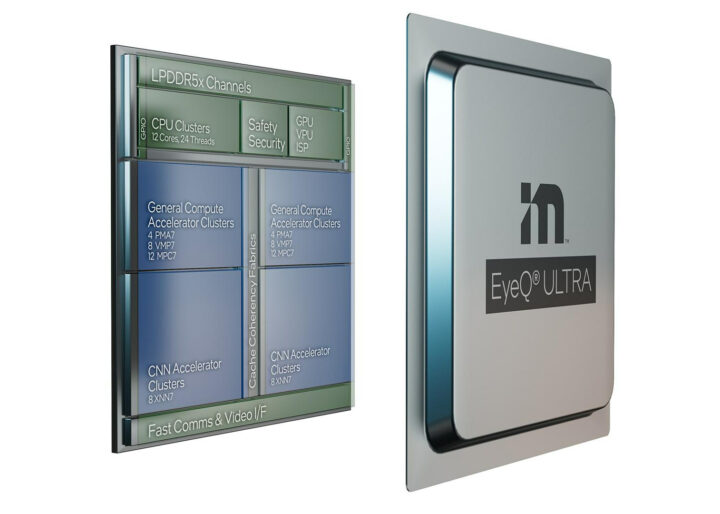Let’s carry on with Intel’s CES 2022 news, but with a twist as Mobileye EyeQ Ultra does not include any x86 cores, but instead, the automotive processor features 12 RISC-V cores, Arm GPU and DSP, and aims to bring Level 4 autonomous driving to cars thanks notably to a 176 TOPS AI accelerator.
The company says EyeQ Ultra packs the performance of 10 EyeQ5s in a single package, with the single chip solution avoiding the power consumption and costs related to integrating multiple SoCs together.
 Intel Mobileye EyeQ Ultra specifications highlights:
Intel Mobileye EyeQ Ultra specifications highlights:
- CPU – 12 RISC-V CPU cores (24 threads)
- GPU – Unnamed Arm GPU
- DSP – Unnamed Arm DSP
- SIMD cores
- VLIW cores
- Coarse grained reconfigurable array (CGRA) cores
- CNN accelerator clusters
- Two sensing subsystems
- One camera-only system
- Radar and Lidar combined system
- 5-nanometer process technology
Mobileye provides both the chip and software with for instance high-definition map and driving policy software, and the solution is said to enable “extreme power efficiency with zero performance sacrifices”. While the holy grail of autonomous driving is level 5 with the car doing everything by itself and a steering wheel is not even needed, level 4 autonomous driving is the next best thing with no driver attention required but only in specific areas or circumstances, and outside or those the car must be able to safely park and a human driver takes over.
We do not have that many details right now as the first engineering samples are planned for the end of 2023. and full automotive-grade production is scheduled for 2025. The chip should be mostly integrated into electric cars and robotaxis.
Via Intel press release and additional information from Anandtech

Jean-Luc started CNX Software in 2010 as a part-time endeavor, before quitting his job as a software engineering manager, and starting to write daily news, and reviews full time later in 2011.
Support CNX Software! Donate via cryptocurrencies, become a Patron on Patreon, or purchase goods on Amazon or Aliexpress





I think it’s a smart move. They’re probably anticipating that such products will progressively need to be 100% auditable down to the silicon in the near future (at least after a few accidents provoke scandals), and that using more open technologies will allow them to release all requested info without having to disclose any of the secret sauce they want to keep for themselves. And as a byproduct it allows them to come back in front of Arm without having to license their CPU cores.
RISC-V with Hyper Thread? Nice
Oh, I missed that. I wonder if these are just the upgraded MIPS i8500 cores then, which is the RISC-V version of the MIPS Warrior i6500F that is in Mobileye EyeQ5. It would likely be a trivial replacement, compared to using x86, Arm or some other RISC-V core.
Blue screen of Death car crash anyone ?
Isnt BSOD, WinOS specific rather than hardware.
Since it’s more ;likely to run some sort of linux kernel, more like “carnel-panic” or kernel oops-ie.
pardon the puns. couldnt help it
For people wanting to know more details, there’s a one-hour video about Mobileye solutions. https://www.intel.com/content/www/us/en/newsroom/news/2022-ces-mobileye-event-livestream-replay.html
The processor has a 100W SDP. The BoM cost for a complete autonomous driving system aims to be under $5000.
Might as well be 150W TDP.
It’ll be great with liquid cooling with extra, separate car radiator & pump,
or better yet, hook it up to a car ac unit for maximum OC.
So what city is vying to be the blueteam sidechannel projection competitive driving city? Carrolton? Yuma?